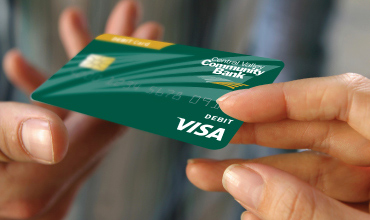1. What is an overdraft?
An overdraft occurs when you do not have enough money in your account to cover a transaction, but the bank pays it anyway. Overdrafts can result from checks, debit cards or other transactions that are paid when the available balance in your deposit account is less than the amount of the transaction, which creates a negative balance in your account.
2. Is an overdraft different from a Non-Sufficient Funds (NSF) item?
Yes, an "NSF item" occurs when an item (such as a check or other transaction presented for payment) is returned unpaid because the available balance in your account is less than the amount of the item. An NSF item that is returned will not result in an overdraft to your account, but Community West Bank may charge a $35 fee.
3. How can I avoid overdrafts?
The best way to avoid overdrafts and associated fees is to manage your account so you don’t overdraw it. We recommend that you:
- Keep track of how much money you have in your checking account. A great way to do this is by monitoring your account balances using personal online banking and other tools such as text alerts for low balance. Remember that some checks and automatic payments may not have cleared yet.
- Pay special attention to your electronic transactions. Record your ATM withdrawals and fees, debit card purchases, and online payments.
- Don’t forget about automatic bill payments you may have set up for utilities, insurance, or loan payments.
- Sometimes mistakes happen. If you do happen to overdraw your account, deposit money into the account as soon as possible to bring the account to a positive balance.
4. What is Occasional Overdraft Service (OOS)?
OOS is a courtesy overdraft service Community West Bank offers to customers with eligible checking accounts in good standing. With OOS we may, at our discretion, pay items presented against your account when you don’t have sufficient available funds. You will still pay an overdraft fee for each item that is paid, but you will avoid the merchants returned item fee. The types of transactions that may be presented against your account include checks, Automated Clearing House (ACH) transactions, recurring debit card transactions, and other withdrawal transactions made using your checking account number.
5. What is an Automated Clearing House (ACH) transaction?
ACH transactions are any recurring pre-authorized debits to pay for transactions, such as, utilities, auto, insurance or mortgage payments.
6. What is Occasional Overdraft Service Plus (OOS Plus)?
OOS Plus offers all the coverage you receive with OOS and also includes ATM transactions and everyday debit card transactions – also known as “one-time” debit card or point of sale (POS) transactions you make at a store, online or by telephone. You must opt-in to activate this service using the OOS Plus Opt-In Consent Form below.
7. What is the difference between OOS and OOS Plus coverage?
OOS Plus covers all of the transactions included in the OOS program, plus the addition of ATM and one-time debit card or POS transactions you make at a store, online or by telephone. OOS Plus requires you to affirmatively “opt-in” by completing and signing the Occasional Overdraft Service Plus Opt-In Consent Form that can be found below and at your local branch.
8. What is a one-time debit card transaction?
This is a transaction where you swipe or use your debit card to pay for services or merchandise, for example, groceries, pharmacy supplies, auto parts, etc. Think of it as any payment for services where you provide your debit card as payment, give your debit card number or swipe the card for the onetime event typically with a merchant.
9. What are the requirements for OOS or OOS Plus?
You must have an eligible account and your account must be maintained in good standing, which includes: continuing to make deposits consistent with your past practices, you are not in default on any loan obligation to us, and your account is not the subject of any legal or administrative order or levy such as bankruptcy or a tax lien.
10. What is an eligible account?
Community West Bank offers a variety of checking accounts to choose from; however, accounts that are considered eligible for both services are:
- Simplicity Checking
- Secure Checking
- Relationship Interest Checking
- Small Business Checking
- Small Business Interest Checking
11. What if I have more than one eligible account?
All eligible accounts come standard with OOS and you can opt-in to OOS Plus on all of your eligible checking accounts if you choose to do so.
12. Does OOS or OOS Plus have a coverage limit?
This discretionary service will not be set to a specific dollar limit, rather it is a dynamic limit applied to your account that may go up or down based on several factors including your account history, deposit activity, and other patterns of account activity.
13. Can I find out what my limit is?
Because the amount of OOS coverage you receive may vary depending on your account activity including age of your account, deposits, various debits and your overdraft patterns, your limit is subject to change.
14. How can I manage my overdrafts if I don't know my limit?
If you are more comfortable with knowing your limit, you may be better served with one of our other overdraft coverage services, such as our Overdraft Transfer Service or Community Credit Line Service.
15. Do I have to participate in OOS Service?
No, you do not have to participate in OOS. If you decide you do not want this service, you may contact us by calling (800) 298-1775 or visiting your local branch to decline the service.
16. How do I opt-In to OOS Plus?
If you want to opt-in to OOS Plus, you need to complete the Occasional Overdraft Service Plus Opt-In Consent Form, located below and at your local branch. This form can be mailed to us or dropped off at your nearest branch.
17. If I choose to Opt-In to OOS Plus and change my mind later, can I opt-out?
Yes, you can opt-out of OOS Plus at any time by calling (800) 298-1775 or visiting your local branch.
18. Are there fees for OOS or OOS Plus?
There is no charge for either service, however we charge a $25 non-sufficient funds fee per transaction during our nightly processing beginning with the first transaction that overdraws your account balance by more than $50 (maximum of 4 fees per business day, for a total of $100 for Consumer Checking accounts and a maximum of 8 fees per business day for a total of $200 for Small Business Checking and Small Business Interest Checking accounts). We charge $10 non-sufficient funds per transaction that is rejected or returned during nightly processing beginning with the first transaction (maximum of 4 fees per business day for a total of $40 for Consumer checking accounts and a maximum of 8 fees per business day for a total of $80 for Small Business Checking and Small Business Interest Checking accounts).
19. Are there alternatives for covering overdrafts?
Yes, and they may be less expensive depending on how you use your account. You should consider our Overdraft Transfer Service and our Community Credit Line (CCL). You may also call (800) 298-1775 for more information on our alternative overdraft services.
20. What if I am unable to bring my account balance positive?
If you’re having trouble bringing your account balance positive, you can call (800) 298-1775 to discuss repayment plans under our Fresh Start program.




